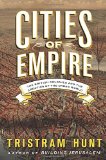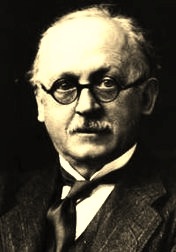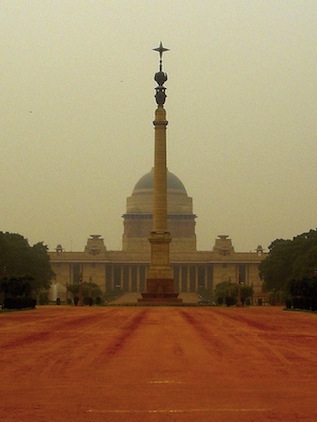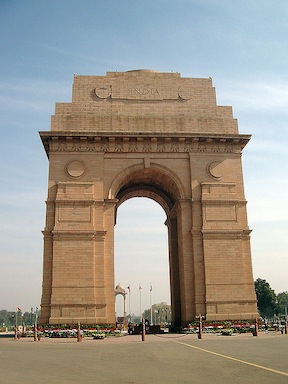Summary | Excerpt | Reviews | Beyond the Book | Read-Alikes | Genres & Themes | Author Bio

 Book Reviewed by:
Book Reviewed by:
Poornima Apte
Buy This Book
This article relates to Cities of Empire
One of the cities Tristram Hunt visits in Cities of Empire is New Delhi, built separate from Delhi (the original Delhi later came to be called "Old Delhi"). In India, the Empire's capital started off in the port city of Calcutta, but Delhi became an increasingly appealing proposition. Once the seat of the Mughals who ruled India for many years, the British felt a move there would be of symbolic importance. What's more, the city is close to the resort town of Shimla, where many British officials routinely moved to during Delhi's stifling summers.
 Many architects designed and built the grand bungalows that are a part of New Delhi's colonial heritage, but credit, unfortunately, is given mostly to one primary architect, Edwin Lutyens (pronounced 'Lootens'). In India, Lutyens, to this day, generates mixed emotions, with many seeing him as an unthinking representative of the Raj who refused to incorporate local culture and traditions into his work, until forced to do so. "Personally, I do not believe there is any real Indian architecture or any great tradition," he is believed to have written, during his initial tour of India in 1912. "Hindon't I say. It is not architecture — the best just clever children, though I own to some of their detail being beautiful." It was quite an irony, then, that a person who refused to acknowledge centuries-old building traditions was broadly put in charge of crafting the new capital of the Empire in India. Hunt gives Lutyens, a relatively easy pass: "...it would be a mistake to regard Lutyens as a chauvinist. Rather, he was an aesthete with an absolute conviction that the architectural principles of classicism should just as well be applied to the plains of Delhi as the estates of Surrey."
Many architects designed and built the grand bungalows that are a part of New Delhi's colonial heritage, but credit, unfortunately, is given mostly to one primary architect, Edwin Lutyens (pronounced 'Lootens'). In India, Lutyens, to this day, generates mixed emotions, with many seeing him as an unthinking representative of the Raj who refused to incorporate local culture and traditions into his work, until forced to do so. "Personally, I do not believe there is any real Indian architecture or any great tradition," he is believed to have written, during his initial tour of India in 1912. "Hindon't I say. It is not architecture — the best just clever children, though I own to some of their detail being beautiful." It was quite an irony, then, that a person who refused to acknowledge centuries-old building traditions was broadly put in charge of crafting the new capital of the Empire in India. Hunt gives Lutyens, a relatively easy pass: "...it would be a mistake to regard Lutyens as a chauvinist. Rather, he was an aesthete with an absolute conviction that the architectural principles of classicism should just as well be applied to the plains of Delhi as the estates of Surrey."
 New Delhi is a relatively new city, its foundations laid in 1911 and completed in 1931. The city's wide boulevards, and especially the central road, Janpath, anchored by Rashtrapati Bhavan on one end, were Lutyens' brainchild, a layout modeled after the likes of Paris and Washington D.C. Rashtrapati Bhavan was once the Viceroy's bungalow, which today, is the President's residence. Interestingly, Lutyens' vision was all right angles (much like New York); it was Lord Hardinge, the British Governor-General at the time, who suggested roundabouts and trees to blunt the force of the sandstorms that routinely plague the city. The final design is a radiating pattern of roads that intersects at hexagonal nodes.
New Delhi is a relatively new city, its foundations laid in 1911 and completed in 1931. The city's wide boulevards, and especially the central road, Janpath, anchored by Rashtrapati Bhavan on one end, were Lutyens' brainchild, a layout modeled after the likes of Paris and Washington D.C. Rashtrapati Bhavan was once the Viceroy's bungalow, which today, is the President's residence. Interestingly, Lutyens' vision was all right angles (much like New York); it was Lord Hardinge, the British Governor-General at the time, who suggested roundabouts and trees to blunt the force of the sandstorms that routinely plague the city. The final design is a radiating pattern of roads that intersects at hexagonal nodes.
The Lutyens' Bungalow Zone is an area that covers roughly 11 square miles — it encompasses beautifully crafted buildings that incorporate a seamless blend of Western (neo-classical Greek columns) with Indian elements such as latticework and accents such as elephants. Interestingly, Lutyens designed just a few of the bungalows in this zone. The rest were commissioned to other architects. The most striking feature of these buildings, the red sandstone used in construction, was recommended by local geologists and won over the material that Lutyens originally wanted — marble.
 Lutyens' Delhi is under threat due to a growing population outside the bungalow zone, and commercial interests pointing out that the buildings are a marker of a past the country would soon rather forget. More important, it has been argued that the buildings are difficult to maintain and could make room for urgently needed housing. The Indian National Trust for Art and Cultural Heritage has made preserving this part of New Delhi, which makes up less than two percent of the city, a top priority.
Lutyens' Delhi is under threat due to a growing population outside the bungalow zone, and commercial interests pointing out that the buildings are a marker of a past the country would soon rather forget. More important, it has been argued that the buildings are difficult to maintain and could make room for urgently needed housing. The Indian National Trust for Art and Cultural Heritage has made preserving this part of New Delhi, which makes up less than two percent of the city, a top priority.
Edwin Lutyens, courtesy of Aparida1295
View of Rashtrapati Bhavan, designed by Lutyens, with the Jaipur Column in the foreground, courtesy of Deepak
India Gate, designed by Lutyens, courtesy of Tony Young
Filed under Places, Cultures & Identities
![]() This article relates to Cities of Empire.
It first ran in the January 7, 2015
issue of BookBrowse Recommends.
This article relates to Cities of Empire.
It first ran in the January 7, 2015
issue of BookBrowse Recommends.





The House on Biscayne Bay
by Chanel Cleeton
As death stalks a gothic mansion in Miami, the lives of two women intertwine as the past and present collide.

The Flower Sisters
by Michelle Collins Anderson
From the new Fannie Flagg of the Ozarks, a richly-woven story of family, forgiveness, and reinvention.

The Funeral Cryer by Wenyan Lu
Debut novelist Wenyan Lu brings us this witty yet profound story about one woman's midlife reawakening in contemporary rural China.
Your guide toexceptional books
BookBrowse seeks out and recommends the best in contemporary fiction and nonfiction—books that not only engage and entertain but also deepen our understanding of ourselves and the world around us.